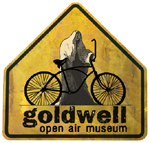History
The Museum began in 1984 with the creation and installation of a major sculpture by Belgian artist Albert Szukalski titled “The Last Supper”–a ghostly interpretation of Christ and his disciples sited against the backdrop of the expansive Amargosa Valley.
To make the life-size ghost figures, Szukalski wrapped live models in fabric soaked in wet plaster and posed them as in the painting “The Last Supper” by Leonardo Da Vinci. When the plaster set, the model was slipped out, leaving the rigid shroud that surrounded him. With more refining, Szukalski then coated the figures with fiberglass making them impervious to weather.
In subsequent years, six additional pieces were added to the site by three other Belgian artists who, like Szukalski, were major figures in European art with extensive exhibition records, but who chose to create in relative obscurity in the Nevada desert near Death Valley in the early 1990s.
Founders Charles Morgan and Suzanne Hackett first became involved with Szukalski in 1994 while conducting a survey of the outdoor sculpture in Southern Nevada for the national “Save Outdoor Sculpture!” project, which was sponsored by the Nevada Arts Council, the Smithsonian Institution, and the National Institute for the Conservation of Cultural property. In 1996, they organized an exhibition at the Contemporary Arts Collective in Las Vegas about the site, and established a first website for the Museum, helping the Museum gain recognition on a national scale.
Albert Szukalksi died in January 2000, and the Goldwell property and its artworks came into the sole ownership of Szukalski’s business partner who lives in Amargosa Valley. An agreement was reached in March 2000 to establish a 501(c)3 organization to which the partner planned to donate the property and ownership of the artworks.
The Museum received its federal tax exemption in April 2001. With its 501(c)3 designation as a public charity, the Museum became eligible to receive public support in the form of grants and individual contributions, enabling it to grow into a viable cultural asset for the residents of Nye County and its visitors.

